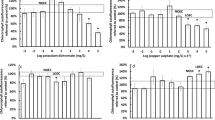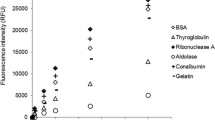Abstract
Certain pseudomonads are capable of producing phenazines—pigmented, reversibly redox-active metabolites that induce a variety of physiological effects on the producing organism as well as others in their vicinity. Environmental conditions and the specific physiological state of cells can dramatically affect the absolute amounts and relative proportions of the various phenazines produced. The method detailed here—high-performance liquid chromatography coupled to detection by UV–Vis absorption—can be used to separate and quantify the amount of phenazines in a Pseudomonas culture. Simple spectrophotometric measurements of filtered culture supernatants can be used to quantify certain oxidized phenazines, such as pyocyanin, in cultures. For cases where the conditions under study are not planktonic cultures (e.g., soil or biofilms) extracting the phenazines may be a necessary first step.
Access this chapter
Tax calculation will be finalised at checkout
Purchases are for personal use only
Similar content being viewed by others
References
Mavrodi DV, Blankenfeldt W, Thomashow LS (2006) Phenazine compounds in fluorescent Pseudomonas spp. biosynthesis and regulation. Ann Rev Phytopath 44:417–445
Mavrodi DV, Bonsall RF, Delaney SM, Soule MJ, Phillips G, Thomashow LS (2001) Functional analysis of genes for biosynthesis of pyocyanin and phenazine-1-carboxamide from Pseudomonas aeruginosa PAO1. J Bacteriol 183:6454–6465
Davis G, Thornalley PJ (1983) Free radical production from the aerobic oxidation of reduced pyridine nucleotides catalysed by phenazine derivatives. Biochim Biophys Acta 724:456–464
Hassan HM, Fridovich I (1980) Mechanism of the antibiotic action of pyocyanine. J Bacteriol 141:156–163
Rabaey K, Boon N, Hofte M, Verstraete W (2005) Microbial phenazine production enhances electron transfer in biofuel cells. Environ Sci Technol 39:3401–3408
Yong Y-C, Yu Y-Y, Li C-M, Zhong J-J, Song H (2011) Bioelectricity enhancement via overexpression of quorum sensing system in Pseudomonas aeruginosa-inoculated microbial fuel cells. Biosens Bioelectron 30:87–92
Lau GW, Hassett DJ, Ran H, Kong F (2004) The role of pyocyanin in Pseudomonas aeruginosa infection. Trends Mol Med 10:599–606
Chin-A-Woeng T, Bloemberg G, Lugtenberg B (2003) Phenazines and their role in biocontrol by Pseudomonas bacteria. New Phytologist 157:503–523
Wang Y, Newman DK (2008) Redox reactions of phenazine antibiotics with ferric (hydr)oxides and molecular oxygen. Environ Sci Technol 42:2380–2386
Hernandez ME, Kappler A, Newman DK (2004) Phenazines and other redox-active antibiotics promote microbial mineral reduction. Appl Environ Microb 70:921–928
Ramos I, Dietrich LEP, Price-Whelan A, Newman DK (2010) Phenazines affect biofilm formation by Pseudomonas aeruginosa in similar ways at various scales. Res Microbiol 161:187–191
Wang Y, Wilks JC, Danhorn T, Ramos I, Croal L, Newman DK (2011) Phenazine-1-carboxylic acid promotes bacterial biofilm development via ferrous iron acquisition. J Bacteriol 193: 3606–3617
Dietrich LEP, Okegbe C, Price-Whelan A, Sakhtah H, Hunter RC, Newman DK (2013) Bacterial community morphogenesis is intimately linked to the intracellular redox state. J Bacteriol 195(7):1371–1380
Price-Whelan A, Dietrich LEP, Newman D (2007) Pyocyanin alters redox homeostasis and carbon flux through central metabolic pathways in Pseudomonas aeruginosa PA14. J Bacteriol 189:6372–6381
Wang Y, Kern SE, Newman DK (2010) Endogenous phenazine antibiotics promote anaerobic survival of Pseudomonas aeruginosa via extracellular electron transfer. J Bacteriol 192:365–369
Dietrich LEP, Price-Whelan A, Petersen A, Whiteley M, Newman DK (2006) The phenazine pyocyanin is a terminal signalling factor in the quorum sensing network of Pseudomonas aeruginosa. Mol Microbiol 61:1308–1321
Koley D, Ramsey MM, Bard AJ, Whiteley M (2011) Discovery of a biofilm electrocline using real-time 3D metabolite analysis. Proc Natl Acad Sci U S A 108:19996–20001
Sullivan NL, Tzeranis DS, Wang Y, So PTC, Newman D (2011) Quantifying the dynamics of bacterial secondary metabolites by spectral multiphoton microscopy. ACS Chem Biol 6:893–899
Reszka KJ, O'Malley Y, McCormick ML, Denning GM, Britigan BE (2004) Oxidation of pyocyanin, a cytotoxic product from Pseudomonas aeruginosa, by microperoxidase 11 and hydrogen peroxide. Free Radic Biol Med 36:1448–1459
Morales DK, Jacobs NJ, Rajamani S, Krishnamurthy M, Cubillos-Ruiz JR, Hogan DA (2010) Antifungal mechanisms by which a novel Pseudomonas aeruginosa phenazine toxin kills Candida albicans in biofilms. Mol Microbiol 78:1379–1392
Hunter RC, Klepac-Ceraj V, Lorenzi MM, Grotzinger H, Martin TR, Newman DK (2012) Phenazine content in the cystic fibrosis respiratory tract negatively correlates with lung function and microbial complexity. Am J Respir Cell Mol Biol 47:738–745
Fernandez RO, Pizarro RA (1997) High-performance liquid chromatographic analysis of Pseudomonas aeruginosa phenazines. J Chromat A 771:99–104
Acknowledgments
S.E.K. was supported by the National Science Foundation Graduate Research Fellowship Program, and D.K.N. is a Howard Hughes Medical Institute (HHMI) Investigator. We thank the HHMI for supporting our work. R. Hunter, H. Sakhtah, C. Okegbe, and L. Dietrich provided constructive criticism of earlier drafts of this chapter.
Author information
Authors and Affiliations
Corresponding author
Editor information
Editors and Affiliations
Rights and permissions
Copyright information
© 2014 Springer Science+Business Media New York
About this protocol
Cite this protocol
Kern, S.E., Newman, D.K. (2014). Measurement of Phenazines in Bacterial Cultures. In: Filloux, A., Ramos, JL. (eds) Pseudomonas Methods and Protocols. Methods in Molecular Biology, vol 1149. Humana, New York, NY. https://doi.org/10.1007/978-1-4939-0473-0_25
Download citation
DOI: https://doi.org/10.1007/978-1-4939-0473-0_25
Published:
Publisher Name: Humana, New York, NY
Print ISBN: 978-1-4939-0472-3
Online ISBN: 978-1-4939-0473-0
eBook Packages: Springer Protocols




